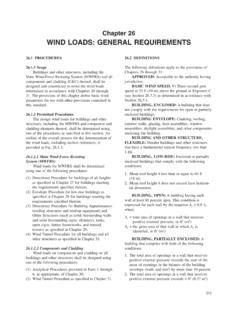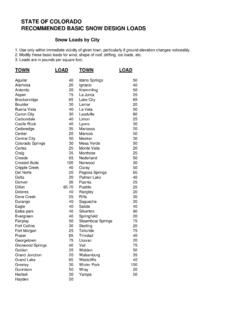Transcription of Chapter 26 WIND LOADS: GENERAL REQUIREMENTS
1 Chapter 26. wind LOADS: GENERAL REQUIREMENTS . PROCEDURES DEFINITIONS. Scope The following de nitions apply to the provisions of Buildings and other structures, including the Chapters 26 through 31: Main wind -Force Resisting System (MWFRS) and all APPROVED: Acceptable to the authority having components and cladding (C&C) thereof, shall be jurisdiction. designed and constructed to resist the wind loads BASIC wind SPEED, V: Three-second gust determined in accordance with Chapters 26 through speed at 33 ft (10 m) above the ground in Exposure C. 31. The provisions of this Chapter de ne basic wind (see Section ) as determined in accordance with parameters for use with other provisions contained in Section this standard. BUILDING, ENCLOSED: A building that does not comply with the REQUIREMENTS for open or partially Permitted Procedures enclosed buildings.
2 The design wind loads for buildings and other BUILDING ENVELOPE: cladding , roo ng, structures, including the MWFRS and component and exterior walls, glazing, door assemblies, window cladding elements thereof, shall be determined using assemblies, skylight assemblies, and other components one of the procedures as speci ed in this section. An enclosing the building. outline of the overall process for the determination of BUILDING AND OTHER STRUCTURE, the wind loads, including section references, is FLEXIBLE: Slender buildings and other structures provided in Fig. that have a fundamental natural frequency less than 1 Hz. Main wind -Force Resisting BUILDING, LOW-RISE: Enclosed or partially System (MWFRS) enclosed buildings that comply with the following wind loads for MWFRS shall be determined conditions: using one of the following procedures: 1.
3 Mean roof height h less than or equal to 60 ft (1) Directional Procedure for buildings of all heights (18 m). as speci ed in Chapter 27 for buildings meeting 2. Mean roof height h does not exceed least horizon- the REQUIREMENTS speci ed therein; tal dimension. (2) Envelope Procedure for low-rise buildings as speci ed in Chapter 28 for buildings meeting the BUILDING, OPEN: A building having each REQUIREMENTS speci ed therein; wall at least 80 percent open. This condition is (3) Directional Procedure for Building Appurtenances expressed for each wall by the equation Ao Ag (rooftop structures and rooftop equipment) and where Other Structures (such as solid freestanding walls Ao = total area of openings in a wall that receives and solid freestanding signs, chimneys, tanks, positive external pressure, in ft2 (m2).)
4 Open signs, lattice frameworks, and trussed Ag = the gross area of that wall in which Ao is towers) as speci ed in Chapter 29; identi ed, in ft2 (m2). (4) wind Tunnel Procedure for all buildings and all other structures as speci ed in Chapter 31. BUILDING, PARTIALLY ENCLOSED: A. building that complies with both of the following Components and cladding conditions: wind loads on components and cladding on all 1. The total area of openings in a wall that receives buildings and other structures shall be designed using positive external pressure exceeds the sum of the one of the following procedures: areas of openings in the balance of the building (1) Analytical Procedures provided in Parts 1 through envelope (walls and roof) by more than 10 percent.
5 6, as appropriate, of Chapter 30; 2. The total area of openings in a wall that receives (2) wind Tunnel Procedure as speci ed in Chapter 31. positive external pressure exceeds 4 ft2 ( m2). 241. Chapter 26 wind LOADS: GENERAL REQUIREMENTS . Chapter 26- GENERAL REQUIREMENTS : Use to determine the basic parameters for determining wind loads on both the MWFRS and C&C. These basic parameters are: Basic wind speed, V, see Figure , B or C. wind directionality factor, Kd , see Section Exposure category, see Section Topographic factor, Kzt, see Section Gust Effect Factor, see Section Enclosure classification, see Section Internal pressure coefficient, (GCpi ), see Section 26-11. wind loads on the MWFRS may be wind loads on the C&C may be determined by: determined by: Chapter 27: Directional procedure for buildings of all heights Chapter 30: - Envelope Procedure in Parts 1 and 2, or - Directional Procedure in Parts 3, 4 and 5.
6 Chapter 28: Envelope procedure for low rise - Building appurtenances (roof overhangs buildings and parapets) in Part 6. Chapter 29: Directional procedure for building appurtenances (roof overhangs and parapets) and other structures Chapter 31: wind tunnel procedure for any building or other structure Chapter 31: wind tunnel procedure for any building or other structure FIGURE Outline of Process for Determining wind Loads. Additional outlines and User Notes are provided at the beginning of each Chapter for more detailed step-by-step procedures for determining the wind loads. or 1 percent of the area of that wall, whichever is BUILDING OR OTHER STRUCTURE, smaller, and the percentage of openings in the REGULAR-SHAPED: A building or other structure balance of the building envelope does not exceed having no unusual geometrical irregularity in spatial 20 percent.
7 Form. BUILDING OR OTHER STRUCTURES, These conditions are expressed by the following RIGID: A building or other structure whose funda- equations: mental frequency is greater than or equal to 1 Hz. BUILDING, SIMPLE DIAPHRAGM: A. 1. Ao > building in which both windward and leeward wind 2. Ao > 4 ft2 ( m2) or > , whichever is loads are transmitted by roof and vertically spanning smaller, and Aoi/Agi wall assemblies, through continuous oor and roof where diaphragms, to the MWFRS. BUILDING, TORSIONALLY REGULAR. Ao, Ag are as de ned for Open Building UNDER wind load : A building with the Aoi = the sum of the areas of openings in the building MWFRS about each principal axis proportioned so envelope (walls and roof) not including Ao, that the maximum displacement at each story under in ft2 (m2) Case 2, the torsional wind load case, of Fig.
8 , Agi = the sum of the gross surface areas of the does not exceed the maximum displacement at the building envelope (walls and roof) not including same location under Case 1 of Fig. , the basic Ag, in ft2 (m2) wind load case. 242. MINIMUM DESIGN LOADS. COMPONENTS AND cladding (C&C): through (monoslope, pitched, or troughed) in Elements of the building envelope that do not qualify an open building with no enclosing walls underneath as part of the MWFRS. the roof surface. DESIGN FORCE, F: Equivalent static force to GLAZING: Glass or transparent or translucent be used in the determination of wind loads for other plastic sheet used in windows, doors, skylights, or structures. curtain walls. DESIGN PRESSURE, p: Equivalent static GLAZING, IMPACT RESISTANT: Glazing pressure to be used in the determination of wind loads that has been shown by testing to withstand the for buildings.
9 Impact of test missiles. See Section DIAPHRAGM: Roof, oor, or other membrane HILL: With respect to topographic effects or bracing system acting to transfer lateral forces to in Section , a land surface characterized by the vertical Main wind -Force Resisting System. For strong relief in any horizontal direction (see analysis under wind loads, diaphragms constructed of Fig. ). untopped steel decks, concrete lled steel decks, and HURRICANE PRONE REGIONS: Areas concrete slabs, each having a span-to-depth ratio of vulnerable to hurricanes; in the United States and its two or less, shall be permitted to be idealized as rigid. territories de ned as Diaphragms constructed of wood structural panels are 1. The Atlantic Ocean and Gulf of Mexico permitted to be idealized as exible.
10 Coasts where the basic wind speed for Risk DIRECTIONAL PROCEDURE: A procedure Category II buildings is greater than 115 mi/h, and for determining wind loads on buildings and other 2. Hawaii, Puerto Rico, Guam, Virgin Islands, and structures for speci c wind directions, in which the American Samoa. external pressure coef cients utilized are based on past wind tunnel testing of prototypical building IMPACT PROTECTIVE SYSTEM: Construc- models for the corresponding direction of wind . tion that has been shown by testing to withstand the EAVE HEIGHT, he: The distance from the impact of test missiles and that is applied, attached, or ground surface adjacent to the building to the roof locked over exterior glazing. See Section eave line at a particular wall.





